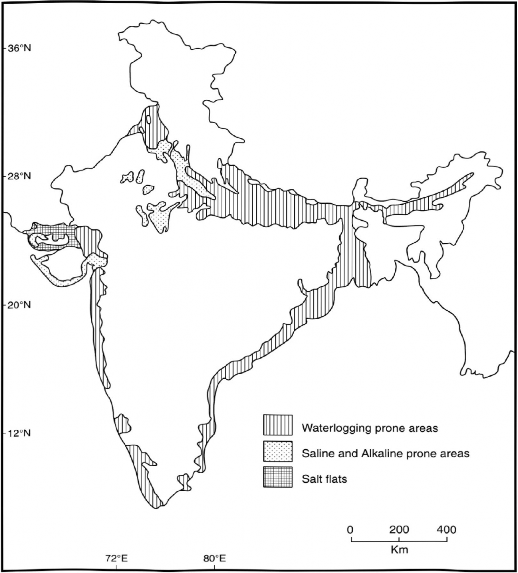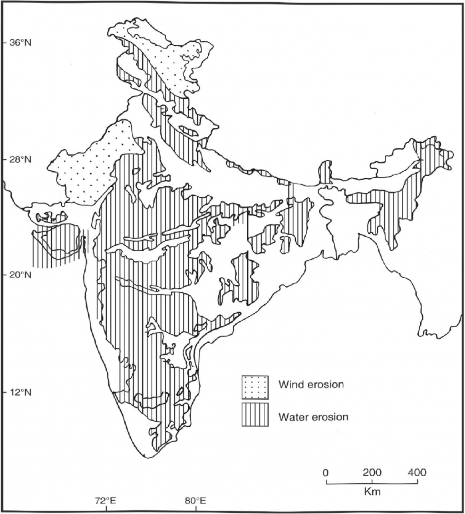(v) Salt Flats
The soils seriously damaged by the excess of calcium chlorides are found in the Rann of Kachchh (Fig. 6.7). These soils are saline, marshy and infested with tall grasses, bushes and scrubs. They are almost useless from agricultural point of view. A sound strategy needs to be developed to bring the salt flats under agriculture or pastures.

Fig. 6.7 Soil Affected Areas
The Planning Commission, on the basis of data provided by the Ministry of Agriculture in 1985, mentions the types of degraded soils/land and their causes. These categories of land and their causes have been given in Tables 6.2 and 6.3.
Table 6.2 Types of Degraded Land
Categories | Area in million hectares |
Gullied lands | 1SSf> |
Land with/without scrub | 19.40 |
Water logged and marshy lands | 1.66 |
Land affected by salinity and alkalinity | 2.05 |
Shifting cultivation area | 3.51 |
Under utilised/de graded forests | 14.06 |
Degraded pastures and grazing lands | 2.60 |
Degraded land under plantation crops | 0.58 |
Sand (inland/coastal) | 5.00 |
Mining/industrial wasteland | 0.12 |
Barren rock/strong waste sheet rock area | 6.42 |
Steep sloping area | 0.77 |
Snow covered/glacial area | 5.58 |
Total | 63.80 1 |
Source: Planning Commission and Five Year Plan, New Delhi, p. 582
Table 6.3 Causes and Extent of Degradation
Causes of degradation | Area in million hectares | Total Area percentage |
Water erosion | 107.12 | 61.71 |
Wind erosion | 17.79 | 10.25 |
Ravines | 3.97 | 2.28 |
Salt affected | 7.61 | 4.38 |
Water logging | 8.52 | 4.91 |
Degraded forest land | 19.49 | 11.23 |
Special problems | 2.73 | 1.57 |
Coastal sandy areas | 1.46 | 0.84 |
Degraded land due to shifting cultivation | 4.91 | 2.83 |
Total | 173.60 | 100.00 | |
Source: Planning Commission and Five Year Plan, New Delhi, p. 582.
The causes of soil degradation differ from region to region and from place to place. In some places, it is due to water erosion, while at others it is due to wind erosion, or salt and toxic chemicals.
It may be seen from Table 6.2 that over 2 million hectares of land is gullied and about 1.66 million hectares are waterlogged and marshy lands. Moreover, 3.51 million hectares are adversely affected by shifting cultivation. The degraded notified forests cover over 14 million hectares and over 19 million hectares of land is without scrub. These lands need immediate attention for reclamation.
Water and wind erosion are the most potent causes of land degradation. Water erosion produces gully erosion, while water and wind erosion lead to sheet erosion. Wind erosion becomes active when the vegetation is removed from the land and land is exposed to wind action. Soil degradation by wind and water erosion have been shown in Fig. 6.8. It may be observed from this figure that wind erosion is mainly in the Thar desert while soil erosion by water is well spread in the Himalayas, Gangetic plains and the Peninsular India (Fig. 6.8). Intensive agricultural practices that rely heavily on water, chemical fertilisers, and insecticides and pesticides have caused water-logging and salinity in many parts of India. The expansion of irrigation without proper drainage has accentuated this. The extent of degraded land is not precisely known. According to land use statistics 2002, published by the Department of Agriculture of India, the estimates of cultivable wastelands are 13.9 million hectares (Table 6.2).

